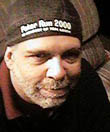|
|
 
|
|
Author
|
Topic: How did a Brenograph work?
|
|
|
Stephen Furley
Film God

Posts: 3059
From: Coulsdon, Croydon, England
Registered: May 2002
|
 posted 05-23-2007 12:08 PM
posted 05-23-2007 12:08 PM




Tim, the Brenograph is a complex piece of equipment, which can be fitted with many different attachments, and configured to do many different things.
Basically it consists of two low-intensity carbon arc lamphouses, each fitted with a condenser lens. at the front of the machine, in front of each lantern is a turret which can hold four projection lenses of different focal lengths. These lenses are fixed in position, unlike most projectors where they can be moved backwards and forwards for focusing. The image from the Brenograph is instead focused by moving the lamphouse, and with it whatever it is that is being projected, along the rails, relative to the lens. This is done by turning the crank handle near to each lantern. Attached to the front rails are small metal indices, which can be moved to indicate a correct position for some particular job. For example, the Brenograph could be used to project moving patterns onto the curtain before a show, but then project song words from a slide onto the screen; The curtain would be in a different position to the screen, the slide holder would be in a different position to the effects glass holder, and the lens could be a different focal length, so the lamphouse would need to be moved between the two uses, and the indicies could be set up beforehand to indicate the correct positions.
The image from the two lanterns was not projected directly onto the screen, curtains or whatever, but via a periscope arrangement of mirrors. the light from the top lantern would hit a fixed mirror at 45 degrees, which would direct it downwards, then a second mirror would turn it forwards again. The beam from the lower lantern was directed upwards and then forwards, in a similar way. There were two reasons for this: firstly, it brought the two beams closer together, so the port could be smaller, and secondly, the second mirror could be tilted, in two axies, by adjusting screws, so that the image could be moved about, without moving the whole machine. The second mirror was actually two mirrors, each adjustable independently, mounted on a sliding turret, so that they could be pre-set, and either could be quickly moved into position. You could even move them while operating; for example to project an image of a setting sun.
Each lantern was fitted with an iris do dim the light, and these could either be used independently, of they could be locked together, so that the image could be disolved from one lantern to the other by moving a single lever.
The Brenograph could project standard size glass slides, textured glass effects plates, cut-out gobos etc., and there were vertical and horizontal shutters to shape the beam, and a second iris in the focal plane could be used to adjust its size. Colour filters could be used, either singly, or in a rorating colour wheel.
Put all that lot together and you could do just about anything with it. I seem to remember that Brenkert said that it 'Projects everything except the motion picture'.
I've only ever actually operated one once, many years ago. It sometimes helps to have three or four hands!
| IP: Logged
|
|
|
|
|
|
|
|
|
|
All times are Central (GMT -6:00)
|
|
Powered by Infopop Corporation
UBB.classicTM
6.3.1.2
The Film-Tech Forums are designed for various members related to the cinema industry to express their opinions, viewpoints and testimonials on various products, services and events based upon speculation, personal knowledge and factual information through use, therefore all views represented here allow no liability upon the publishers of this web site and the owners of said views assume no liability for any ill will resulting from these postings. The posts made here are for educational as well as entertainment purposes and as such anyone viewing this portion of the website must accept these views as statements of the author of that opinion
and agrees to release the authors from any and all liability.
|

 Home
Home
 Products
Products
 Store
Store
 Forum
Forum
 Warehouse
Warehouse
 Contact Us
Contact Us




 Printer-friendly view of this topic
Printer-friendly view of this topic










